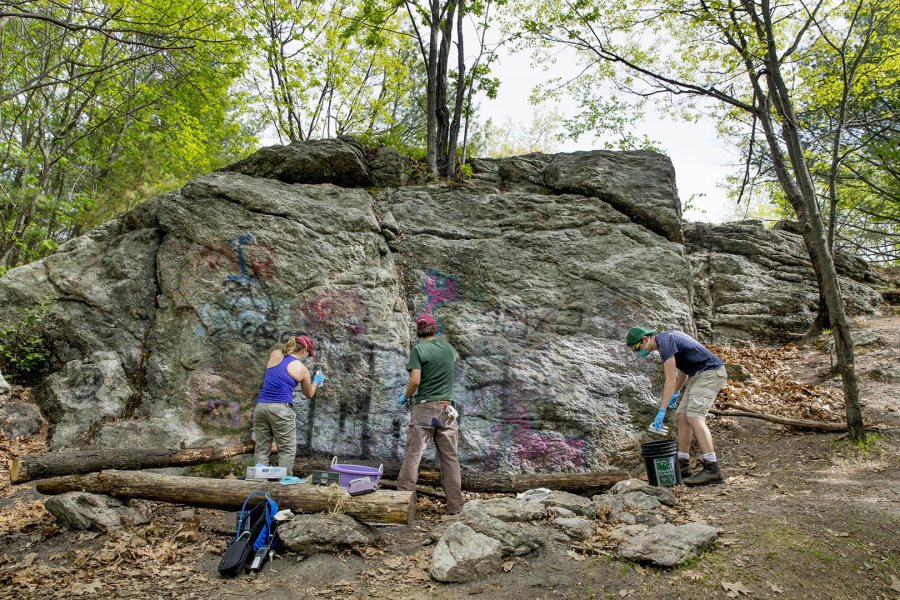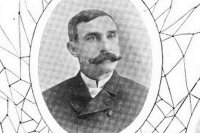
Is the student-led Mount David cleanup a model for a litter-free hill?
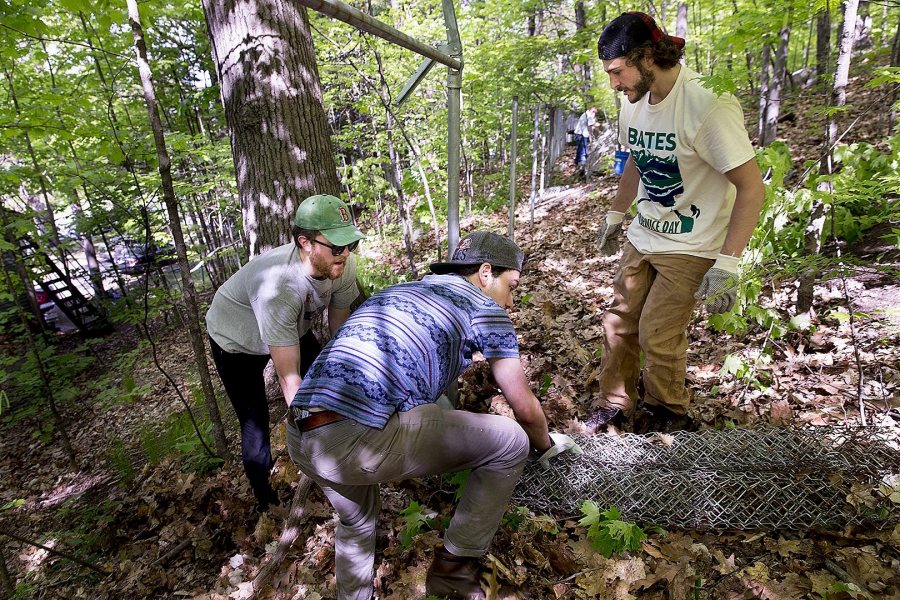
During the May 21 cleanup of Mount David, from left, Oliver Farnum ’19 of Marshfield, Mass., Jeremy Mack ’16 of Brooklyn, N.Y., and George Fiske ’19 of West Hartford, Conn., grapple with old sections of chain-link fencing. (Phyllis Graber Jensen/Bates College)
If the party vibe isn’t quite right, a Bates student can exit the back of a Frye Street house and, 3 minutes later, discover a quiet place above it all.
Mount David, an historic campus spot rising 381 feet above its surroundings, is a curious amalgam of nature, Bates, and Lewiston, a fluid identity that holds both charm and challenge, says Dana Cohen-Kaplan ’16, a campus environmental leader who led a Mount David cleanup this spring.
The hill is a gateway experience for Bates students “just beginning to get outside.”
On the one hand, Mount David is one of those valuable “neutral spaces” that doesn’t feel “owned by any one campus constituency,” Cohen-Kaplan says. It feels open to the community, too. “I’ve watched a lot of sunsets with friends up there. And I’ve had great conversations with Lewiston residents up there.”
The hill is also a gateway experience for Bates students “just beginning to get outside,” he adds. “And if a student enjoys a trip to Mount David, they might feel inclined to check out Thorncrag” and similar offerings.
On the other hand, this neutral Bates space just might need a stronger ally.
“It’s a beautiful spot, but people treat Mount David poorly,” Cohen-Kaplan says, with students and residents being equal-opportunity litterers.
“They treat it poorly because other people treat it poorly. People don’t take their litter away because other people don’t take their litter away.”
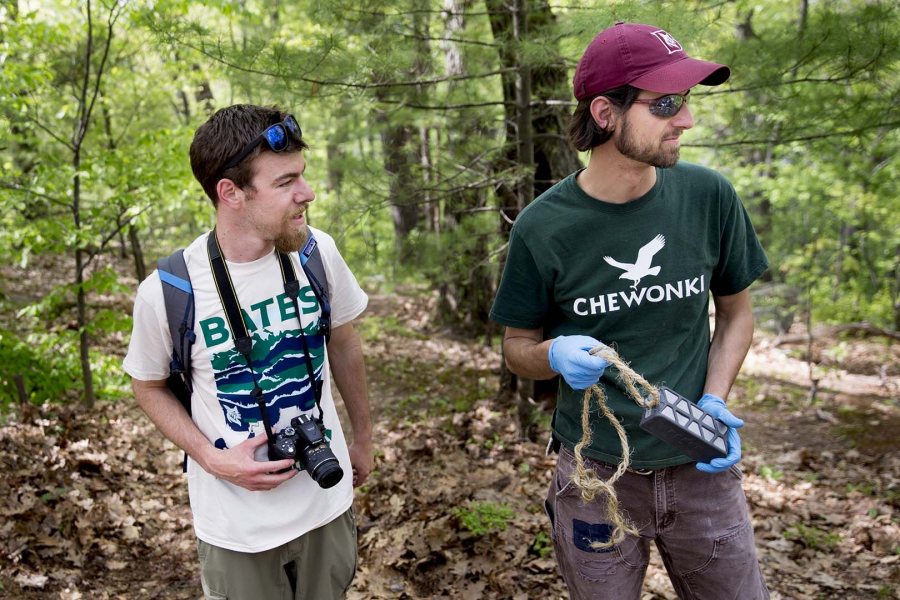
EcoRep leader Dana Cohen-Kaplan ’16 (left) and Bates sustainability manager Tom Twist confer during the EcoService Day project on Mount David on May 21. (Phyllis Graber Jensen/Bates College)
A leader of the student EcoReps organization, Cohen-Kaplan graduated in May with a geology degree and a minor in teacher education, and he spent part of his final Short Term planning and leading a significant cleanup of Mount David, one of four on- and off-campus EcoService Day projects on May 21.
He and his team of EcoReps with support from the college’s Facility Services staff and the Sustainability Office, hauled out trash and broken glass from the hill, removed graffiti, and generally tidied the place up.
Working behind several Frye Street houses, they also removed about 100 feet of derelict chain-link fencing, a vestige of mid-1900s approaches to campus security.
Back then, Bates stewarded Mount David the old-fashioned way. Topped with barbed-wire, the fencing ran around the base of the hill from Rand Hall to Frye Street, with strongly worded “No Trespassing” signs at intervals.
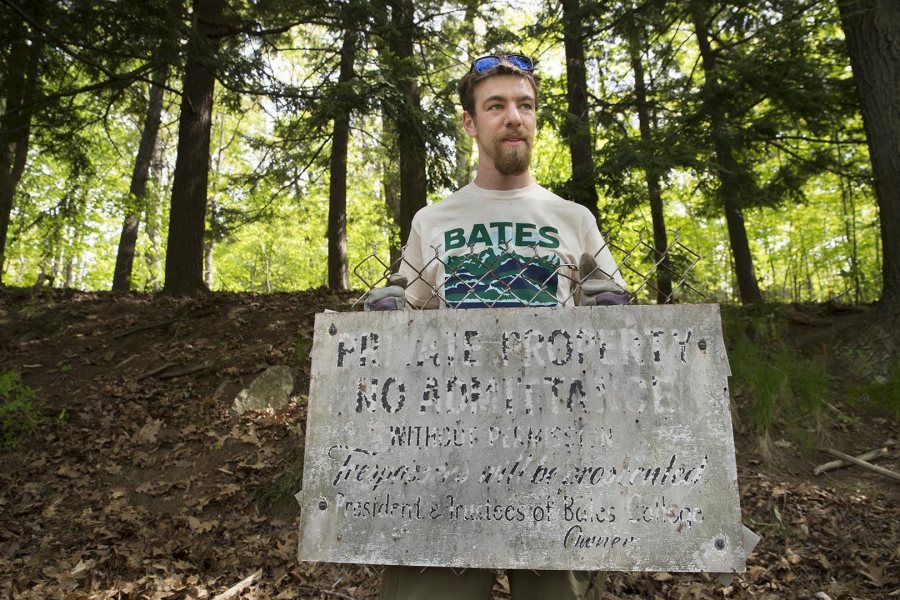
Dana Cohen-Kaplan ’16 holds an old sign that reads, “Private Property: No Admittance Without Permission, Trespassers will be prosecuted, President and Trustees of Bates College, Owner.” (Phyllis Graber Jensen/Bates College)
Besides being a safety issue — the fencing, pushed over in places, was topped with barbed wire — it also “represented boundaries between Bates and Lewiston,” Cohen-Kaplan says, “and that was in our heads as we worked. The fencing is a boundary that’s a remnant of a time that was different.”
Now, “when you look up toward the mountain from most of the Frye Street houses, you can’t see any fencing, which is cool,” he says.
Now the challenge is to keep it clean. As that famous ’70s “Keep America Beautiful” TV commercial intoned, “People start pollution, and people can stop it.”
Yet stopping bad behavior takes more than posting “no littering” signs, says Tom Twist, the college’s sustainability manager. “You can’t beat people over the head with what they should or shouldn’t do.”
Instead, Twist says, a goal might be to change a “keystone habit” among hill users, a simple change that might have “many other positive repercussions.”
One keystone habit that Cohen-Kaplan and Twist would like to change is the use of glass bottles on the mountain, which is linked with the bad habit of tossing them off the hill. “It’s super-laborious to clean up broken glass,” Twists says. “Broken glass begets broken glass.”
“Maybe we can be creative and engaging” with the signage, says Cohen-Kaplan. “Something that speaks to students: ‘Hey, don’t be that guy. You use this mountain, so do other people.’”
Along with some signage, there are plans to install an information kiosk near the trail behind 280 College St. residence (the old Rand Field).
Mount David is one of two “wild” pieces of land on the Bates campus proper, the other being the approximately three-acre parcel of woods near Merrill Gymnasium.
Take a quick hike up Mount David on the path that starts behind Pierce House on Frye Street.
Occupying about 10 acres of the main campus’ 133 acres, Mount David is double the size of the Historic Quad, and it lives large in the Bates consciousness, too.
Chiding the college a bit, Cohen-Kaplan says that since Bates uses the Mount David name as a brand — Mount David Summit, Mount David Society — perhaps the college should also devote resources to upkeep of the namesake space itself. (Speaking of the Summit: the poem “On the Tops of Things,” by Nicole Danser ’15, read at the 2015 Mount David Summit, celebrates all of Mount David’s charms.)
“You can enjoy a space and leave no trace. The two can go together.”
While the college can’t devote buff-and-burnish resources to Mount David as it does with the Historic Quad, the student-college partnership of the May cleanup suggests a sustainable model, says Jay Phillips, director of operations for Bates Facility Services.
“When there is an opportunity to partner, we want our people involved,” Phillips says.
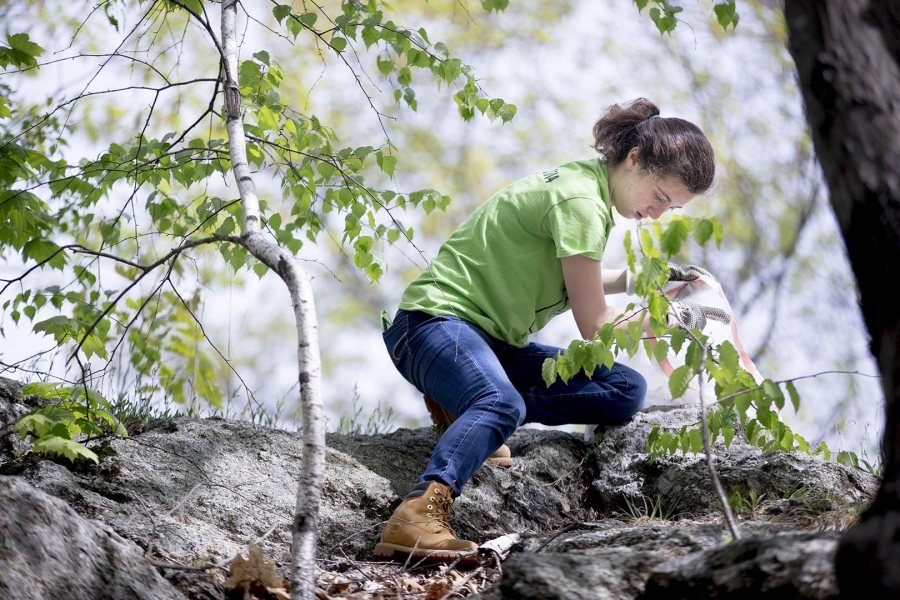
Rachel Minkovitz ’19 of Wilmington, Del., picks up trash on Mount David during the EcoService Day project on May 21. (Phyllis Graber Jensen/Bates College)
Twist agrees. “I would like to continue to have [Mount David stewardship] be student-run, to build ownership of the place. If we had more students cycle through the cleanup, it would improve the culture of the mountain’s use” while instilling sustainable land-use habits among student.
The main message? “You can enjoy a space and leave no trace,” Twist says. “The two can go together.”
Mount David cleanup was among four EcoService projects that included work at the 14-acre David Rancourt River Preserve, owned by the Androscoggin Land Trust; at River Valley Village apartments; at the 372-acre Thorncrag Sanctuary wildlife preserve; and at Lots to Gardens urban gardening program in Lewiston-Auburn.
